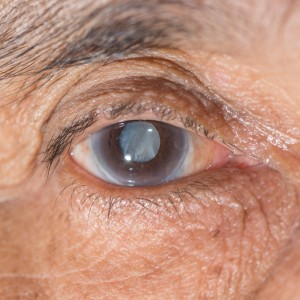
Cataracts are a clouding of the lens in the eye that can be associated with aging. According to the National Institutes of Health, by “age 80, more than half of all Americans either have a cataract or have had cataract surgery.”
Equally as often, however, eye doctors find that many patients wait longer than they should to come in and have an eye exam, leading to this all-too common yet treatable eye issue. By having your vision tested regularly, your eye doctor can catch a developing cataract early, which can mean avoiding surgical treatment, at least until such time as visual impairment progresses past non-surgical interventions.
Sometimes the problem of patients who wait too long between eye exams stems from the fact that cataracts tend to develop slowly, leading some people to assume their vision is simply yet gradually getting worse with age. We recommend routine appointments, as the term “age-related cataracts” is a misnomer — cataracts do not only effect the elderly!
Common Symptoms of Cataracts
To help you know when it’s time for an eye exam to check for cataracts, our ECI blog this month covers the most common symptoms associated with this medical condition. We hope this information will prompt you to make an eye appointment soon, whether for yourself or for a loved one who is having vision problems. Caught early, cataracts can improve with new eyeglasses and patients can often avoid surgery for several years. Cataract symptoms can include:
- Blurry or cloudy vision
- Faded or tinted colors, particularly purples and blues
- Brightness from glare of headlights, lamps, or sunlight becomes bothersome, or you may see a halo around these lights
- Poor night vision
- Double vision
- Frequent prescription changes to your eyeglasses or contact lenses.
When cataracts have advanced past the point where anti-glare sunglasses or a new prescription will help, an ECI ophthalmologist will recommend surgery as the only remaining treatment. Surgery involves removing the cloudy lens and replacing it with an artificial lens called an intraocular lens (IOL).
ECI eye surgeons will only perform cataract surgery on one eye at a time. In the case of our elderly patient, the left eye was worse than the right so surgery was recommended for the more damaged eye first. If you have cataracts in both eyes that require surgery, the surgery will be performed on each eye approximately four to eight weeks apart, depending on your recovery time.
If you suspect you have symptoms that could be cataracts, please contact ECI for en eye exam in our Santa Rosa office as soon as possible.
